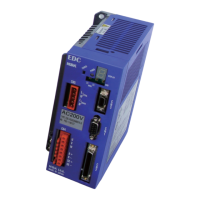— 11-14 —
11.3.12. Alarm E0: RAM Error
The RAM temporally stores the setting of parameters, programs and the important data for the
Driver Unit.
This alarm occurs when the data on the RAM goes to heaven from any reason.
Table 11-19: Cause and Remedy for the alarm E0
Cause Remedy
(1)
The data on the RAM is rewritten
because of noise or other reason.
• Reset the power.
• Take measures against noise.
(2) Defective Driver Unit
If resetting the power does not work, the Driver Unit may be
defective. Replace it referring to “Appendix 4: Procedure for
Replacing the EDC Driver Unit”.
(1) The EEPROM will not back up the inputted settings during this alarm is occurring. (This is to
protect the data on the EEPROM from damage because of the broken data on the RAM.)
(2) You may monitor parameters and programs during the occurrence of the alarm. However the
readout may include damaged data.
11.3.13. Alarm E2: ROM Error
The Driver Unit has the EEPROM to back up the settings of parameters and programs. The
limits for number of times for overwriting and deleting data is approximately 100 000.
(The EEPROM does not require a battery for data backup.)
This alarm occurs when the data is not properly stored on the EEPROM due to its service life, or
the data is not properly overwritten to the EEPROM.
Table 11-20: Cause and remedy for the alarm E2
Cause Remedy
(1)
ROM data have been altered by
noise or other cause.
• Take measures against noise.
• Initialize the memory by the command SI (Set initial parameters),
and then turn on the power again. If the alarm does not occur,
restore the previous parameter settings.
(2)
EEPROM is down because of the life
limit
• If the alarm occurs immediately after the power is reset following
initialization of the ROM, it is very likely that the EEPROM is the
cause.
• Replace the Driver Unit referring to “Appendix 4: Procedure for
Replacing the EDC Driver Unit”.
(1) We recommend setting the command WM1 to prohibit overwriting to the EEPROM for the
application where the master controller frequently changes internal parameters. However, be
sure to execute the command WD (Write Data) before turn off the power if revised parameter
settings must be stored. (Do not turn the power off during execution of the command WD
because it takes approximately 30 seconds.)
(2) Execution of the command SI (Set initial parameters) during occurrence of the alarm will
initialize all settings on the damaged data area.
◊ Besides parameters, some programs and the settings of control inputs and outputs may
be initialized. In such a case, restore the programs and the settings of control inputs and
outputs.

